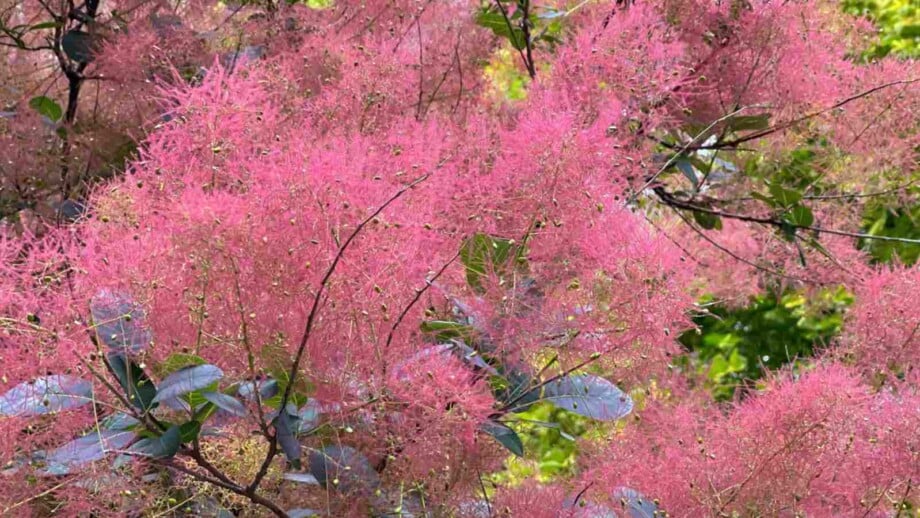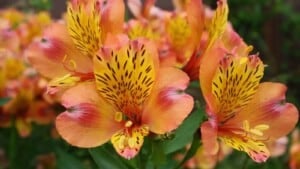The smoke tree, scientifically known as Cotinus, is a captivating plant that can be likened to a magician’s secret. Its defining feature is the fluffy, smoke-like plumes that emerge from its branches during the summer. These plumes aren’t actually smoke but rather clusters of tiny, delicate flowers. The leaves of the smoke tree are known for their vibrant colors, ranging from deep purples to striking reds and soft greens. The contrast between these leaves and the ethereal plumes makes it a visual spectacle in any garden.
Smoke trees come in various species, each with its unique charm. The two most common species are Cotinus coggygria, native to southern Europe, and Cotinus obovatus, native to North America. Cotinus coggygria, often called the European smoke bush, is known for its rich, wine-colored foliage. On the other hand, Cotinus obovatus, also called the American smoke tree, boasts more elongated leaves and is native to the southeastern United States. These varieties can be a stunning addition to your garden, providing different colors and textures.
The smoke tree has more to offer than just its mesmerizing appearance. Historically, Native Americans used the American smoke tree for medicinal purposes. Its leaves and bark were believed to have healing properties, addressing various ailments. In contemporary gardening, smoke trees are valued for their ornamental appeal. They can be pruned into beautiful shapes or allowed to grow freely, adding a touch of elegance to any landscape. Additionally, the plumes can be dried and used in floral arrangements, infusing a touch of magic into your home decor.
The smoke tree has woven its way into the tapestry of various cultures. In ancient Greece, the plant was often associated with the god Dionysus and symbolized the thrill of transformation and celebration. This mystical connection to transformation can be seen in the smoke tree’s ability to transform a garden into a stunning, eye-catching landscape. Its symbolism as a harbinger of change and beauty makes it a cherished addition to many gardens, from Europe to North America.
As a master gardener with years of experience, I’ve cultivated a deep appreciation for smoke trees. In this guide, I’ll provide you with all the essential information about smoke trees, from their enchanting appearance to expert care tips for successful cultivation in your garden.
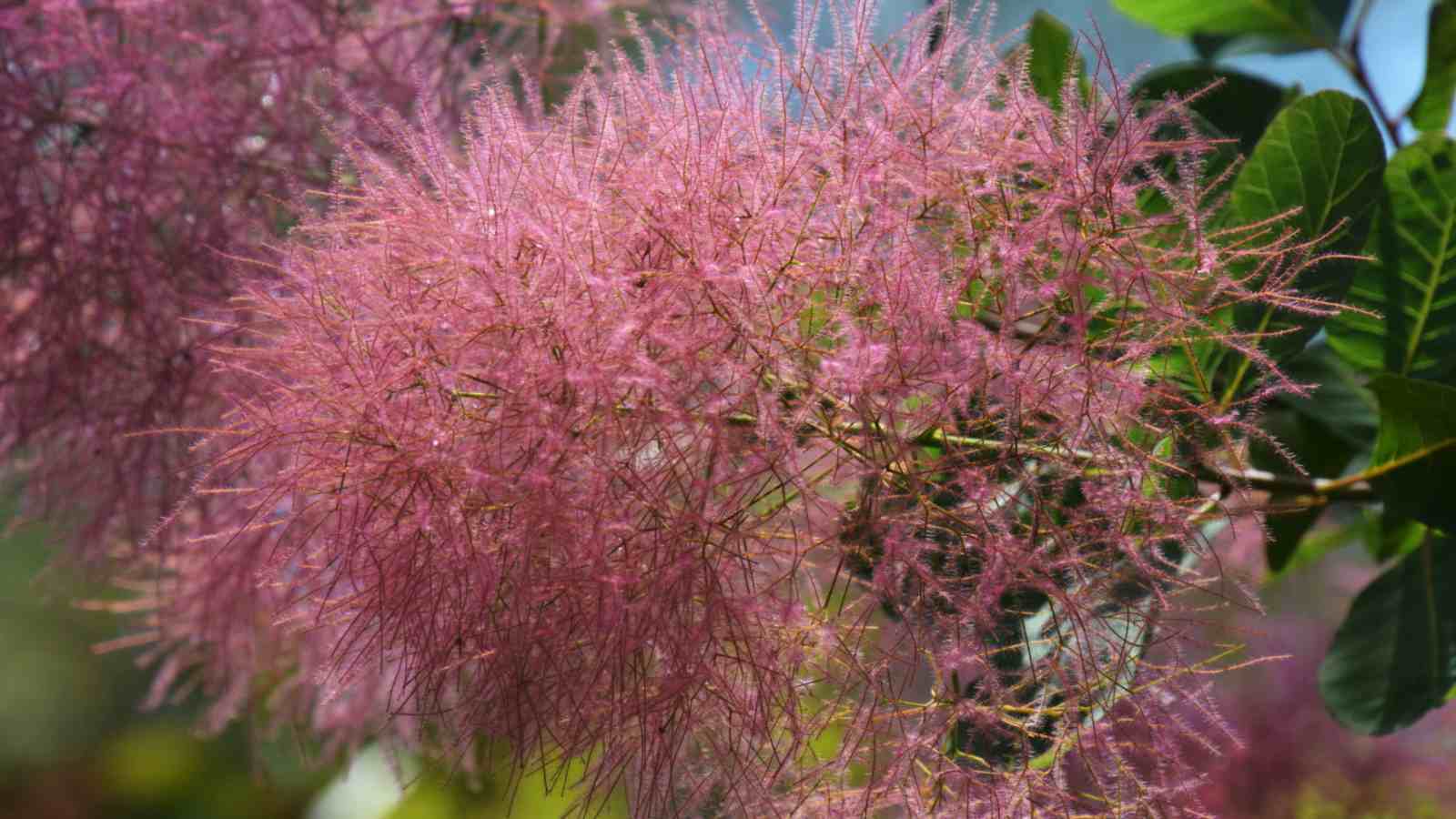
Botanical Name: Cotinus
Common Name: Smoke Tree, Smoke bush, European smoke tree
Family: Anacardiaceae
Plant Type: Deciduous shrub or small tree
Hardiness Zones: Typically zones 5-8, but this may vary based on the specific species or variety
Sun Exposure: Full sun to partial shade
Soil Type: Well-drained, loamy soil
Soil pH: 6.0-7.5 (Slightly acidic to slightly alkaline)
Maturity: 3 to 5 years
Height: 10 to 15 feet (3 to 4.5 meters)
Spacing: 8 to 10 feet (2.4 to 3 meters) apart
Bloom Time: Late spring to early summer
Flower Color: The small flowers form fluffy clusters that can range in color from creamy white to pink or purple, resembling a puff of smoke.
Native Area: Southern Europe, the Mediterranean region, and parts of North America.
Smoke Tree Plant Care
Caring for smoke trees is relatively straightforward, making them an attractive choice for gardeners seeking low-maintenance yet visually striking plants. These deciduous shrubs or small trees thrive in well-drained, loamy soil with a slightly acidic to slightly alkaline pH ranging from 6.0 to 7.5. When it comes to sunlight, smoke trees prefer full sun to partial shade, ensuring they receive at least 6 hours of direct sunlight daily for optimal growth and blooming.
Proper watering is essential, especially during the plant’s establishment phase. Water deeply and regularly, especially during dry spells, to keep the soil consistently moist. Mulching around the base of the smoke tree helps retain moisture and suppresses weeds, promoting a healthy root system. Regular pruning, preferably in late winter or early spring, helps maintain the desired shape and size. Removing dead or damaged branches encourages new growth and enhances the overall appearance of the tree.

Fertilizing smoke trees is necessary to ensure they receive adequate nutrients. A balanced, slow-release fertilizer in spring can support healthy growth and vibrant foliage. Additionally, applying a layer of compost around the tree’s base annually enriches the soil, promoting robust development. Monitoring the plant for pests and diseases is crucial; while smoke trees are relatively resistant, keeping an eye out for issues ensures early detection and effective treatment if necessary.
Light
Light plays a crucial role in the growth and development of smoke trees. These versatile plants have a preference for full sun to partial shade. Providing them with the right amount of sunlight is essential for their overall health and blooming potential. While they can tolerate partial shade, they truly thrive when they receive at least 6 hours of direct sunlight daily.
In regions with hot, intense summers, a bit of afternoon shade can be beneficial to prevent scorching. However, in cooler climates, they can handle full sun without issues. It’s important to observe your local climate and adjust the sun exposure accordingly to ensure your smoke tree receives the ideal light conditions for its optimal growth and the stunning display of its unique, smoky plumes.
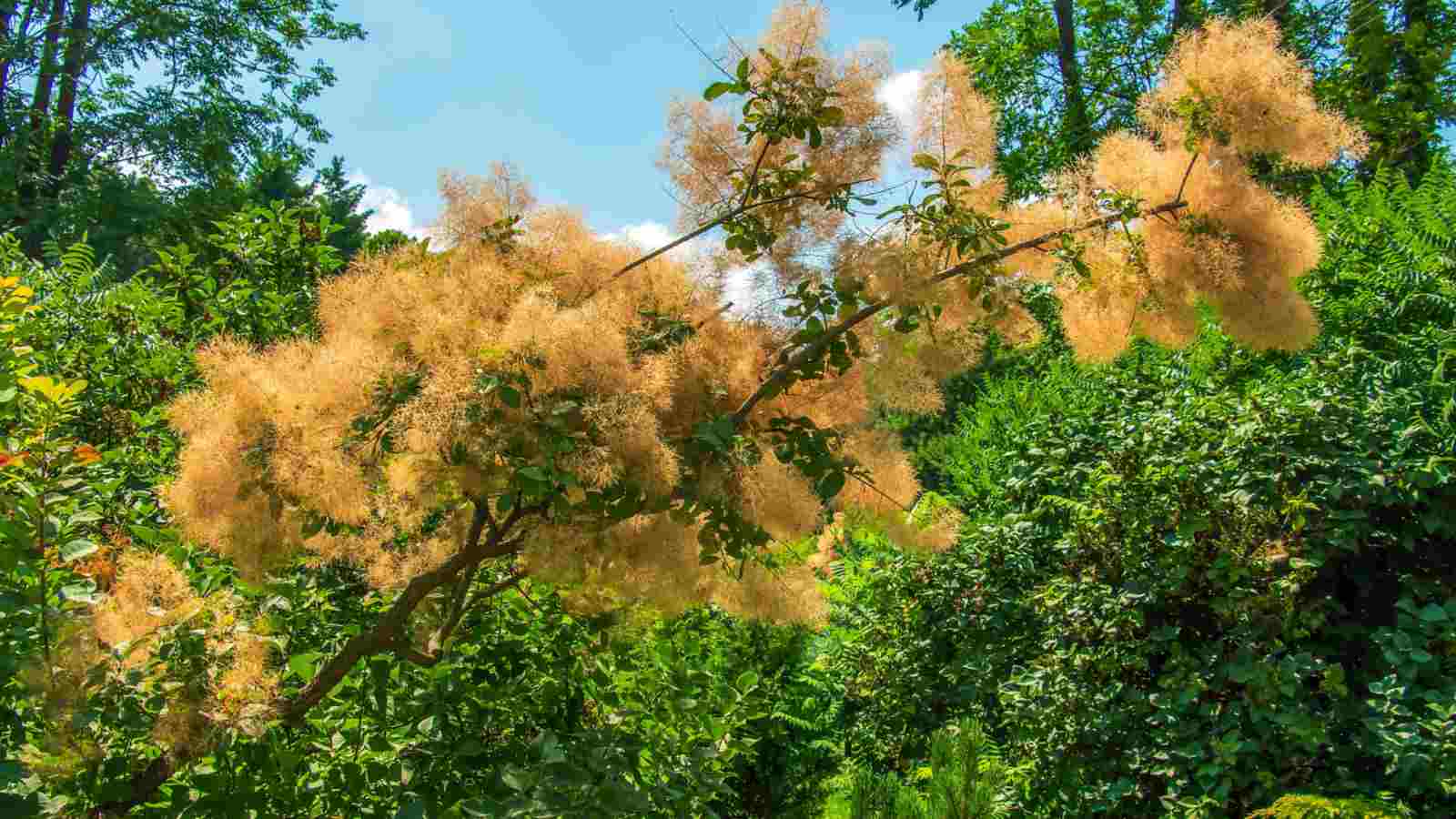
Soil
Smoke trees thrive in well-drained, loamy soil, which provides a balanced environment for their root system. Loamy soil, rich in organic matter, ensures proper aeration and drainage, preventing waterlogged conditions that can harm the plant. While smoke trees are adaptable, they prefer soil with a slightly acidic to slightly alkaline pH ranging from 6.0 to 7.5. This pH range allows the plant to effectively absorb essential nutrients from the soil, supporting robust growth and vibrant foliage.
To enhance the soil quality, gardeners can incorporate organic matter such as compost or well-rotted manure. Adding a layer of mulch around the base of the smoke tree not only conserves soil moisture but also enriches the soil as it decomposes. Proper soil preparation before planting is essential; loosening the soil and amending it with organic materials create an ideal foundation for the smoke tree’s root system to establish itself.
Water
While smoke trees are relatively drought-tolerant once established, consistent and deep watering, especially during their initial years, is crucial for their root development. These plants prefer a moderate moisture level, so it’s essential to strike a balance; overwatering can lead to root rot while underwatering might stunt their growth.
During dry spells or periods without significant rainfall, it’s advisable to provide supplemental irrigation. Water the base of the tree thoroughly, allowing the moisture to penetrate the soil deeply. To maintain an even moisture level and prevent water runoff, consider applying mulch around the smoke tree. Mulching helps retain moisture, regulates soil temperature, and reduces weed competition, ensuring the tree’s roots receive adequate hydration.
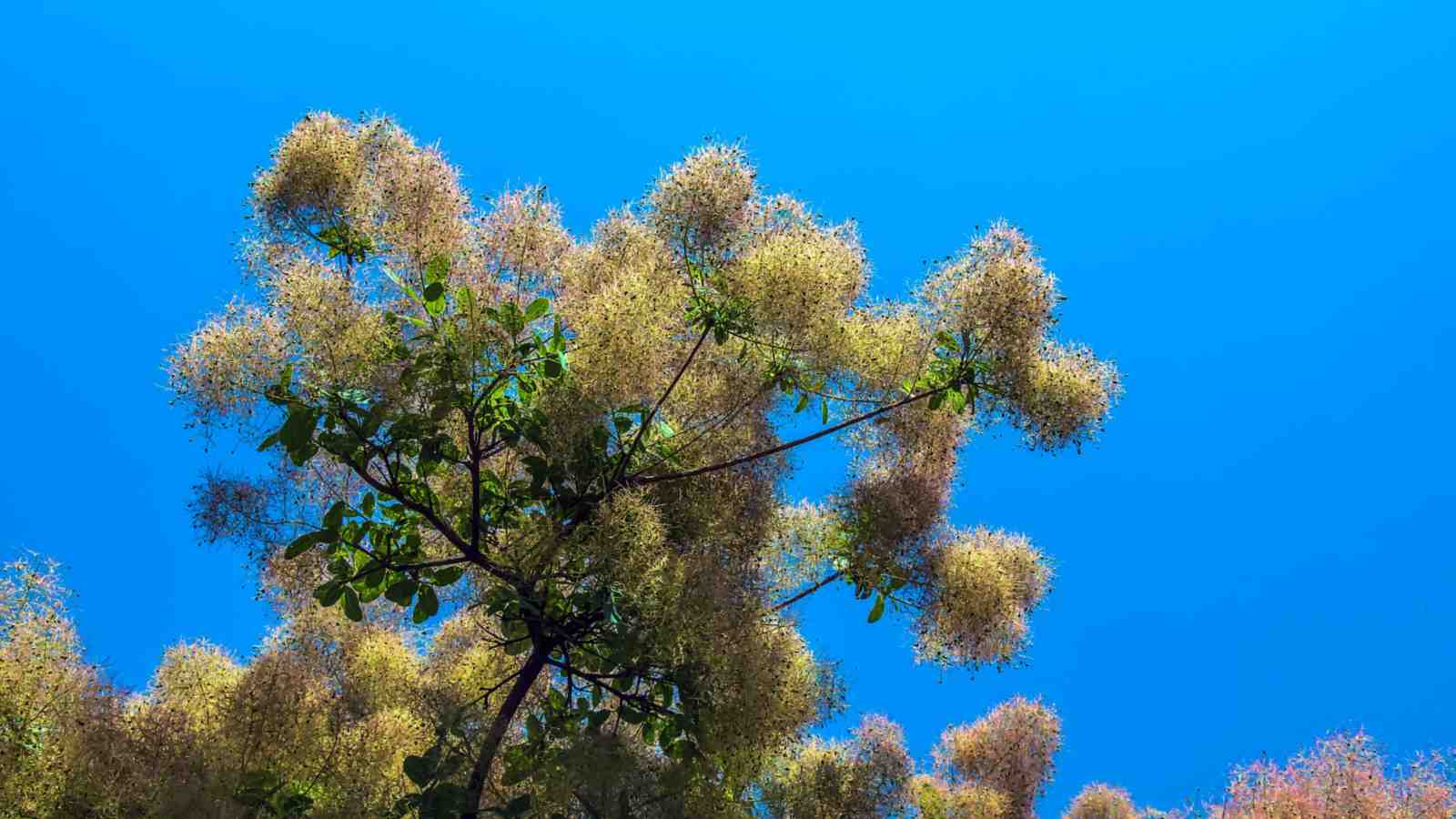
Temperature and Humidity
Generally, they thrive in moderate climates with a balanced mix of warmth and coolness. They are well-suited for hardiness zones 5-8, but specific species or varieties might have slightly different preferences. These plants can endure mild frost but might require protection during harsh winters, especially in colder regions.
In terms of humidity, smoke trees are relatively tolerant and can adapt to varying humidity levels. While they prefer moderate humidity, they can withstand dry and slightly humid conditions. Adequate watering and mulching can help maintain the necessary moisture levels around the plant, ensuring it remains healthy and resilient. Proper care, including regular watering and suitable protection during extreme weather conditions, will help smoke trees flourish regardless of the local temperature and humidity variations.
Fertilizer
Smoke trees benefit from a balanced, slow-release fertilizer with equal proportions of nitrogen (N), phosphorus (P), and potassium (K). Look for a fertilizer labeled with an N-P-K ratio, such as 10-10-10 or 14-14-14, indicating the percentage of each nutrient in the product. Applying fertilizer in early spring, just as the buds begin to swell, provides the plant with essential nutrients for the upcoming growing season.
When applying the fertilizer, it’s essential to follow the manufacturer’s instructions regarding dosage and application methods. Typically, a handful of fertilizer evenly distributed around the tree’s base and gently worked into the soil suffices. Water the area thoroughly after applying the fertilizer to allow the nutrients to penetrate the root zone effectively. Avoid over-fertilization, as excessive nutrients can harm the plant and disrupt its natural balance.

Pruning
The ideal time for pruning smoke trees is in late winter or early spring before the new growth begins. During this time, the tree is dormant, making it less stressful for the plant.
When pruning smoke trees, focus on removing any crossed or rubbing branches to prevent damage. Additionally, thinning out the tree’s interior by cutting back crowded branches enhances air circulation, reducing the risk of diseases. Always use sharp, clean pruning tools to make precise cuts and minimize stress on the tree. It’s essential to step back periodically while pruning to assess the tree’s overall shape and ensure a balanced appearance.
While smoke trees are relatively resilient, it’s advisable not to remove more than one-third of the branches at a time to avoid shocking the plant. Regular, gentle pruning sessions throughout the tree’s life will help maintain its natural form and encourage a profusion of the characteristic smoky blooms. Proper pruning not only enhances the tree’s aesthetic appeal but also promotes healthy growth, ensuring your smoke tree remains a stunning focal point in your garden for years to come.
Overwintering
Before the first frost, thoroughly water the smoke tree thoroughly. Moist soil helps the plant better endure winter conditions. Applying a layer of mulch around the tree’s base, about 2 to 3 inches deep, helps insulate the roots, retaining moisture and providing a buffer against temperature fluctuations.
In areas where winters are particularly severe, consider wrapping the young or vulnerable smoke trees with burlap or using protective covers. This shields them from cold winds and prevents frost damage. Pruning in late fall or early winter is generally discouraged, as it may stimulate new growth that can be harmed by frost. Instead, wait until late winter or early spring to prune, removing dead or damaged branches to encourage healthy regrowth.
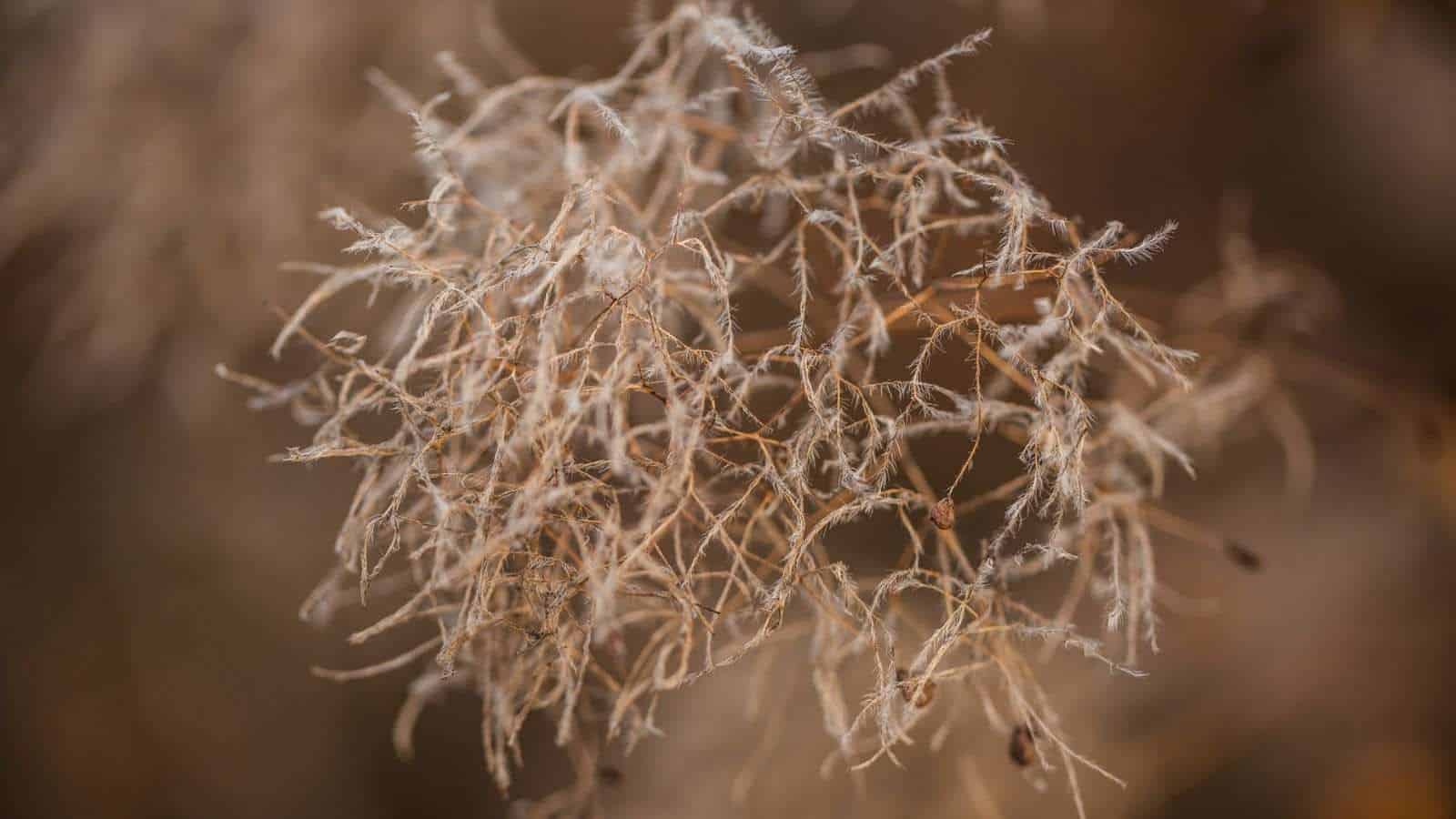
Types of Smoke Trees
European Smoke Bush (Cotinus coggygria)
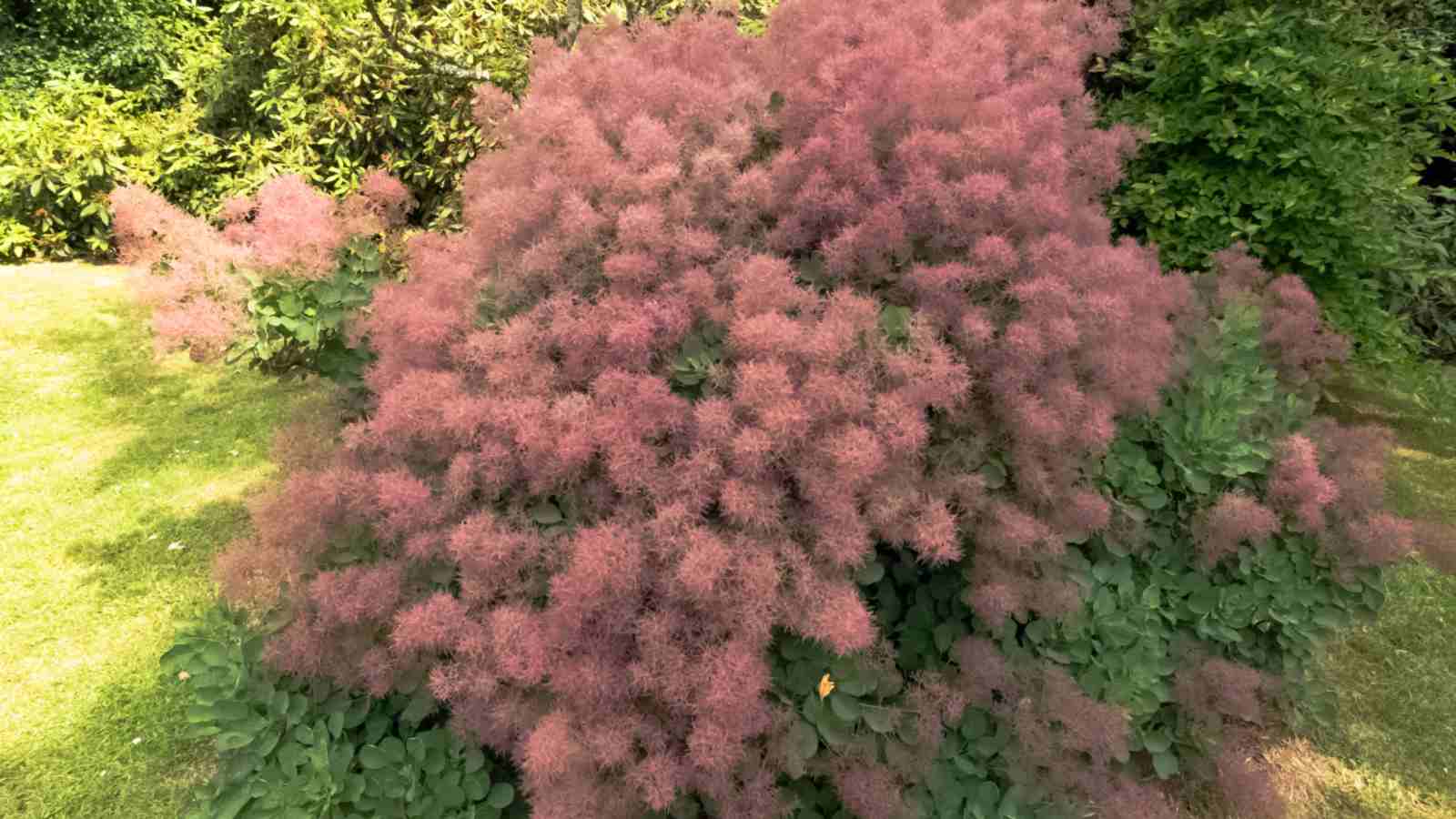
Cotinus coggygria, commonly known as the European Smoke Bush or Eurasian Smoke Tree, is a popular choice among garden enthusiasts. It’s recognized for its striking wine-colored foliage and the fluffy, smoke-like plumes of flowers that emerge during the summer. This species is native to southern Europe and is well-suited to hardiness zones 5-8. It can grow to around 10 to 15 feet (3 to 4.5 meters) and thrives in full sun to partial shade. The European Smoke Bush is a classic choice for those seeking a captivating and low-maintenance ornamental addition to their garden.
American Smoke tree (Cotinus obovatus)
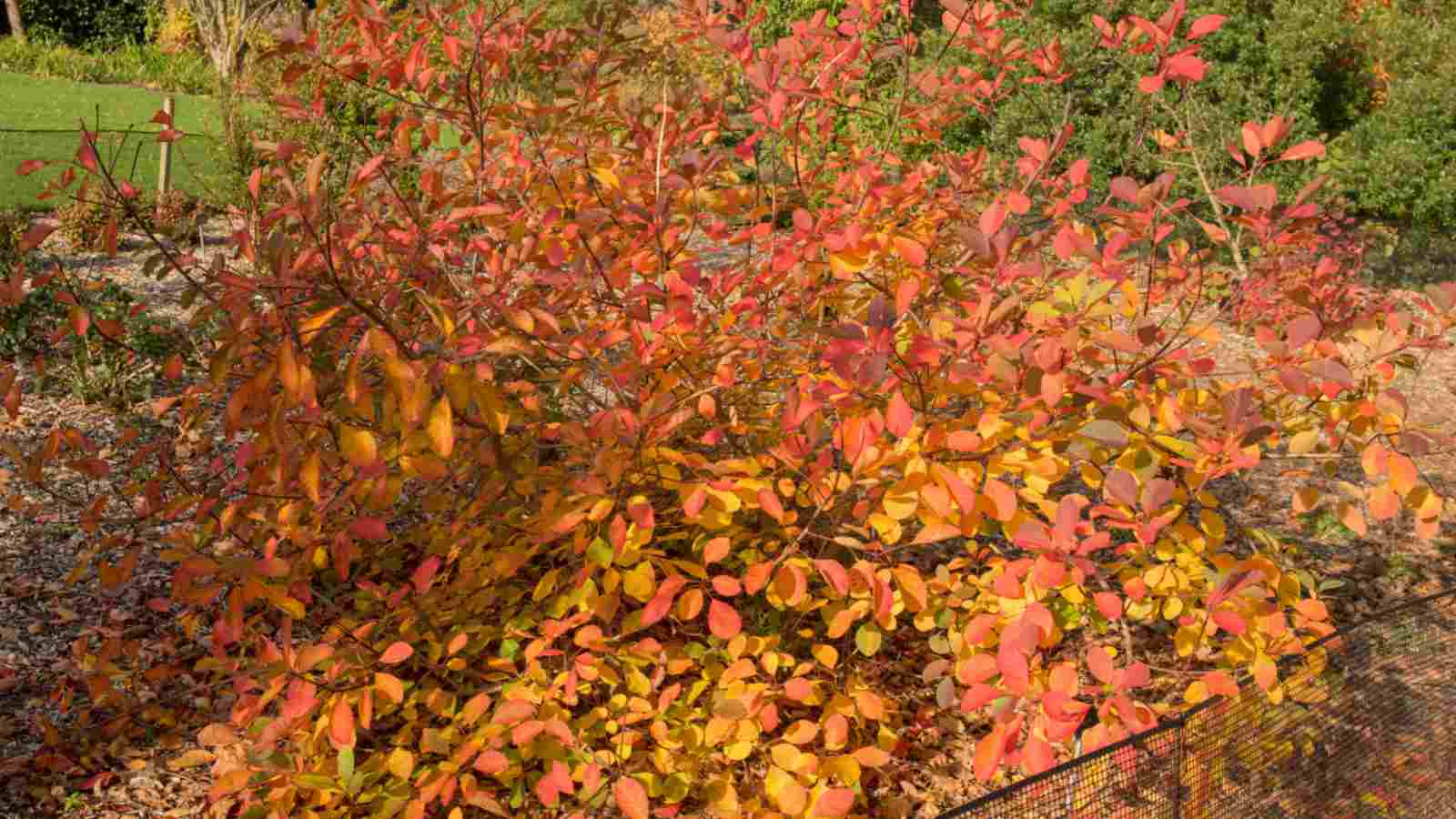
Cotinus obovatus, known as the American Smoketree, is native to the southeastern United States. It’s distinguishable by its elongated leaves and tolerance for various growing conditions. American Smoketrees typically reach heights of 15-20 feet (4.5-6 meters) and are well-suited to hardiness zones 5-8. These varieties are resilient, adaptable, and a great choice for gardeners looking for a hardy native plant that thrives in diverse soil types and sunlight conditions.
Royal Purple Smoke Tree (Cotinus ‘Royal Purple’)
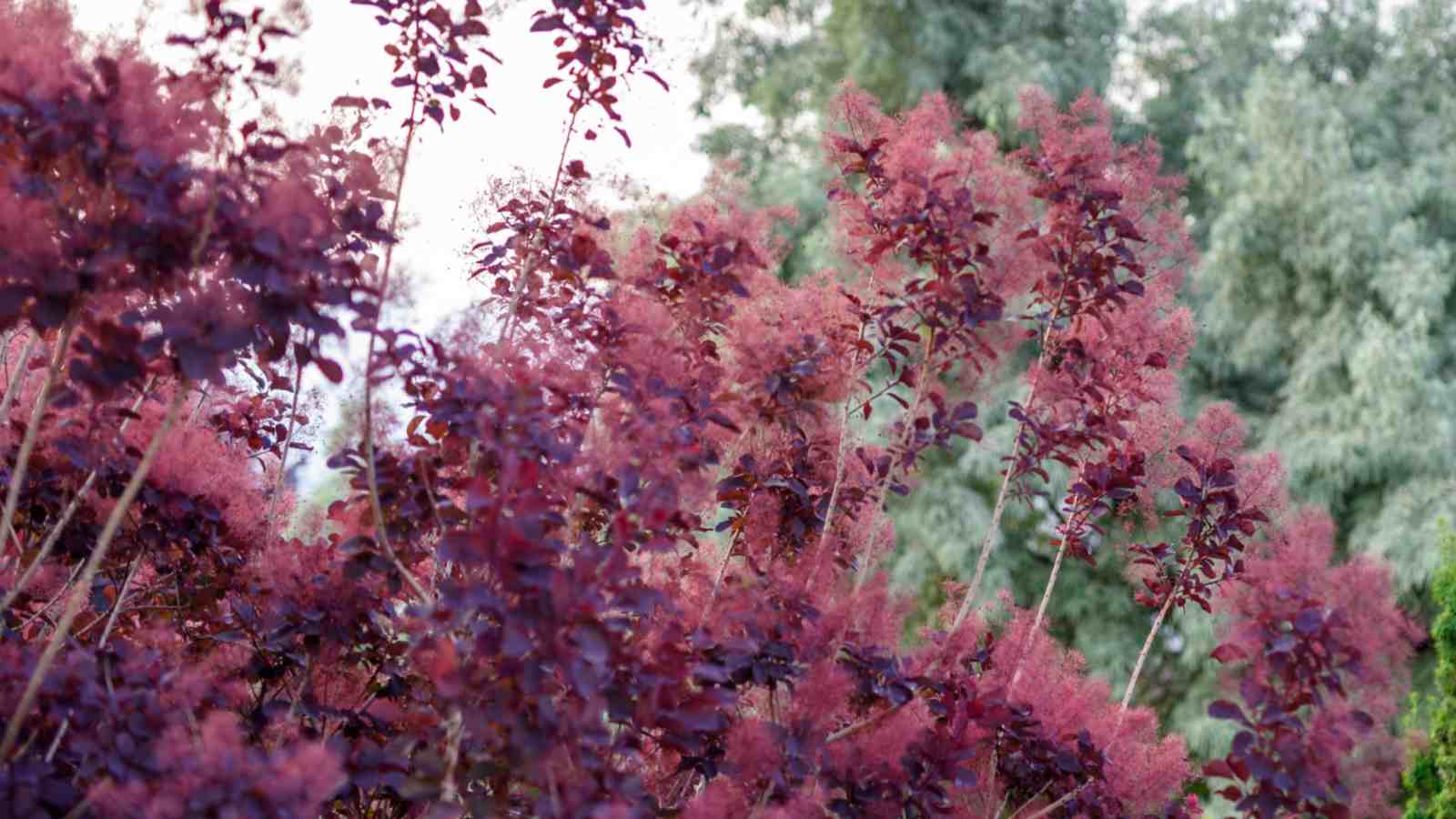
‘Cotinus Royal Purple’ is a popular cultivar of the smoke tree known for its stunning deep purple foliage. This cultivar is prized for its intense color, which adds a dramatic element to any garden. It thrives in hardiness zones 5-8 and is an excellent choice for those who want to make a bold statement in their landscape design. Like its relatives, ‘Royal Purple’ is relatively low-maintenance and appreciates full sun to partial shade.
Golden Spirit Smoke Tree (Cotinus coggyria ‘Ancot’)
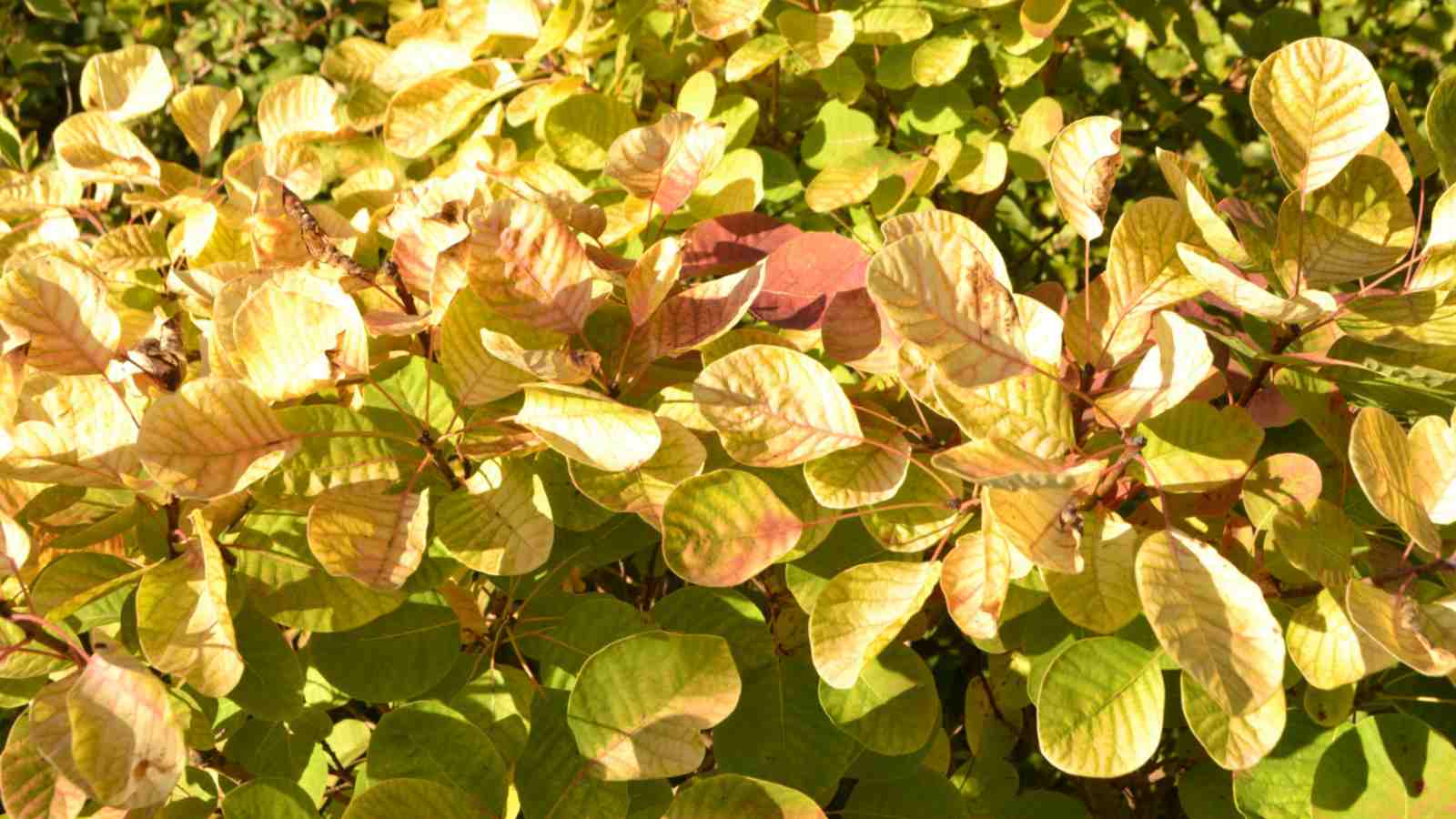
The Golden Spirit Smoke Tree, scientifically known as Cotinus coggygria ‘Ancot,’ is a delightful cultivar with vibrant golden-yellow foliage. This cultivar, hardy in zones 5-8, offers a striking contrast against its counterparts, creating a focal point in any landscape. Its distinctive coloration remains a showstopper throughout the seasons, bringing a touch of sunshine to gardens. Like other smoke trees, ‘Golden Spirit’ enjoys full sun to partial shade and well-drained soil. Its unique hue makes it a popular choice for gardeners aiming to infuse their outdoor space with radiant color and visual appeal.
Velvet Cloak Smoke Tree (Cotinus coggygria ‘Velvet Cloak’)

The ‘Velvet Cloak’ smoke tree (Cotinus coggygria ‘Velvet Cloak’) is a standout cultivar known for its lush, deep purple leaves that resemble velvet, adding a touch of luxury to gardens. Thriving in hardiness zones 5-8, it reaches 10 to 15 feet tall and prefers full sun to partial shade. Its rich foliage creates a striking contrast, making it a favorite choice for landscaping. With easy maintenance and its regal appearance, this cultivar adds sophistication and charm to outdoor spaces, making it highly coveted among plant enthusiasts.
Grace Smoke Tree (Cotinus ‘Grace’)

Cotinus ‘Grace,’ commonly called Grace Smoke Tree, is a unique cultivar prized for its elegant, lace-like foliage that transitions from deep burgundy in spring to vibrant red and orange hues in fall. This eye-catching variety is an excellent addition to gardens and landscapes, offering a blend of beauty and resilience. It thrives in similar conditions as other smoke tree varieties, making it suitable for zones 5-8 and preferring full sun to partial shade.
Nordine Smoke Tree (Cotinus ‘Nordine’)
The ‘Nordine’ smoke tree, with the scientific name of Cotinus ‘Nordine’) a distinctive cultivar, is cherished for its compact growth habit and rich, dark purple leaves. Its compact size makes it a versatile choice for smaller gardens and landscapes, while its captivating color adds depth and contrast to any outdoor space. ‘Nordine’ smoke tree thrives in zones 5-8, needing full sun to partial shade for optimal development. Its low-maintenance nature and aesthetic appeal make it a popular choice among gardeners looking for a visually striking yet manageable plant.
How to Plant Smoke Tree From Seed
Planting smoke trees from seed can be a rewarding experience, allowing you to witness the entire lifecycle of these captivating plants right from the start. Here’s a step-by-step guide to help you get started on this exciting gardening journey.
Step 1: Preparing the Seed
Begin by selecting high-quality smoke tree seeds from a reliable supplier or collect them from mature smoke trees in your vicinity. To enhance germination, it’s advisable to soak the seeds in lukewarm water for 24 hours before planting. This process helps soften the seed coat, encouraging quicker and more successful germination.

Step 2: Planting the Seed
Once the seeds have been soaked, prepare a well-draining seed-starting mix in pots or seed trays. Plant the seeds about 1/4 inch deep in the soil and cover them lightly. Ensure the soil remains consistently moist but not waterlogged to support germination. Place the pots in a warm, well-lit area, such as a sunny windowsill, to provide the seeds with the necessary light and warmth.
Step 3: Providing the Right Conditions
As the seeds germinate and seedlings emerge, maintain a consistent watering schedule to keep the soil evenly moist. Transplant the seedlings into larger containers when they develop their first true leaves. Once the seedlings have reached a suitable size and the danger of frost has passed, they can be planted outdoors in a well-prepared garden bed or a spacious container.
Step 4: Addressing Common Pests and Problems
Keep a watchful eye on your smoke tree seedlings for any signs of pests or diseases. Common issues include aphids, caterpillars, or powdery mildew. To address these problems, consider natural remedies like neem oil for pests or a baking soda solution for mildew. Regularly inspecting the plants allows you to detect issues early and take appropriate action, ensuring the health of your smoke trees.
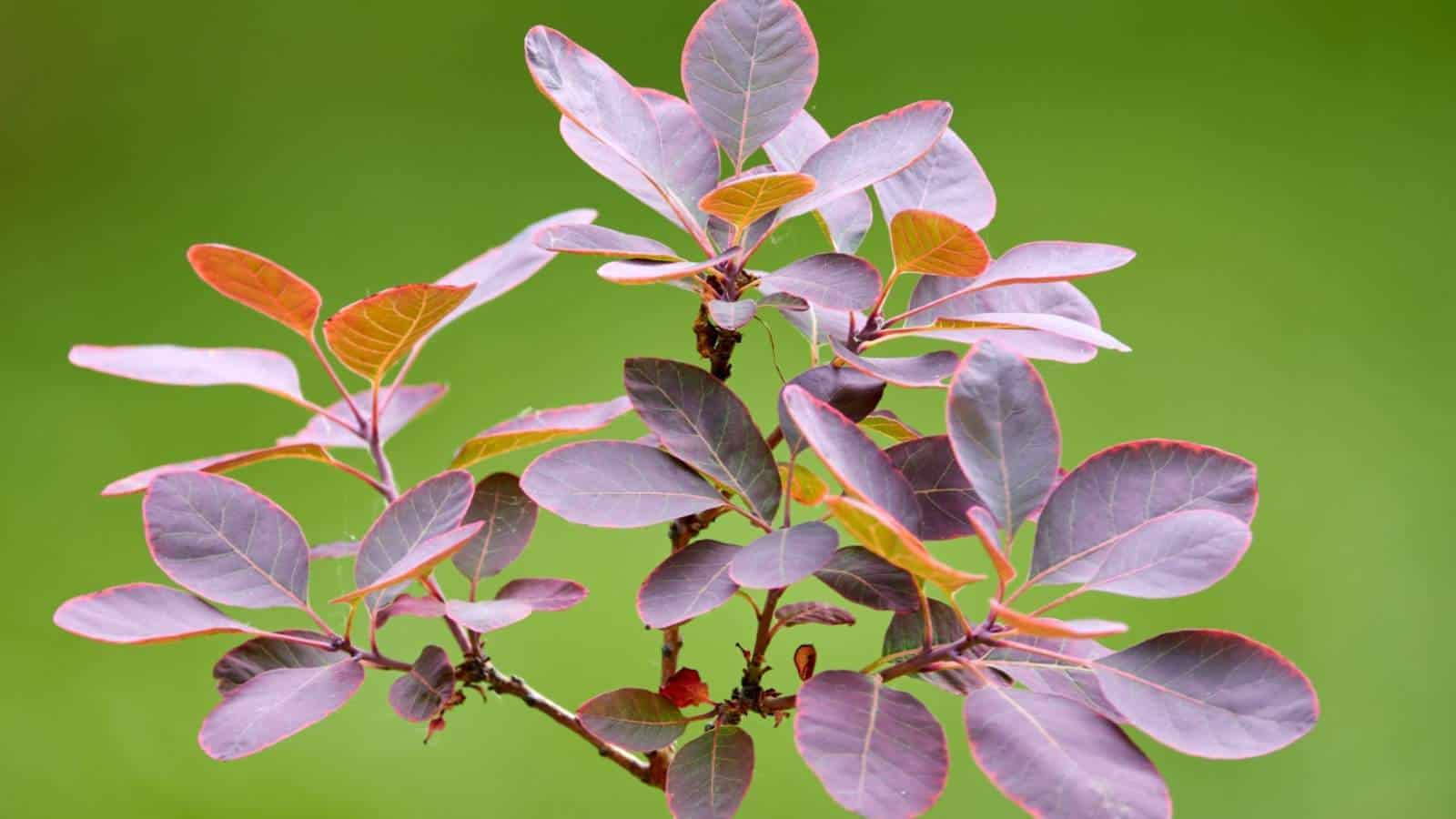
Step 5: Flowering and Aftercare
With proper care, your smoke tree seedlings will eventually mature and produce their signature fluffy plumes of flowers. Once they start flowering, continue to provide adequate water and occasional fertilization to support healthy growth and blooming. Prune the smoke tree to maintain its shape and encourage more prolific flowering. Regular aftercare, including mulching and periodic checks for pests and diseases, will help your smoke tree thrive and become a stunning focal point in your garden.
Common Pests and Plant Diseases for Smoke Tree
Dealing with pests and diseases can be a challenge for any gardener, but being well-informed and proactive can make a significant difference in the health and vitality of your smoke trees. Let’s explore some common issues that might affect your smoke trees and learn how to tackle them effectively.
Aphids

Aphids, those minuscule, sap-sucking insects, are a common nuisance for smoke trees. These pests can quickly multiply and weaken the plant by draining its vital juices. You might notice distorted leaves, sticky honeydew residue, or the presence of ants, which often farm aphids for their sweet secretions. To control aphids, consider introducing natural predators like ladybugs or lacewings. Alternatively, a gentle spray of soapy water can help dislodge these pesky insects. Regularly inspect the undersides of leaves where aphids tend to hide, and promptly address any infestations to keep your smoke tree healthy and vibrant.
Powdery Mildew

Powdery mildew is a common fungal disease affecting smoke trees, especially in humid or crowded conditions. It appears as a white, powdery substance on the leaves, hindering photosynthesis and weakening the plant. Adequate air circulation and proper spacing between plants can prevent powdery mildew. If your smoke tree does fall victim to this fungus, a mixture of baking soda and water sprayed on the leaves can help control its spread. Regular pruning for better air movement and avoiding overhead watering can reduce the risk of powdery mildew, ensuring your smoke tree remains robust and disease-free.
Caterpillars

Caterpillars, the larval stage of butterflies and moths, can devour smoke tree leaves, causing unsightly holes and compromising the plant’s health. While it might be tempting to use chemical insecticides, consider a more environmentally friendly approach. Handpicking caterpillars is an effective method, especially for smaller infestations. Encouraging natural predators like birds and beneficial insects, such as parasitoid wasps, can also help keep caterpillar populations in check. Regularly inspect your smoke trees, especially during the growing season, and act promptly to protect them from these voracious eaters.
Verticillium Wilt
Verticillium wilt is a soil-borne fungus that can affect various plants, including smoke trees. This silent invader enters the plant through its roots and obstructs the vascular system, causing wilting, yellowing leaves, and, in severe cases, plant death. Unfortunately, once a plant is infected, there’s no cure. However, prevention is key. Choose resistant smoke tree varieties and avoid planting in areas where plants susceptible to verticillium wilt previously grew. Proper sanitation practices, such as removing and destroying affected plants, can prevent the disease from spreading. Ensuring good soil drainage and avoiding stress on the plant, such as overwatering or underwatering, can also reduce the risk of verticillium wilt, preserving the health of your smoke trees.
Leaf Spots
Leaf spots, caused by various fungi or bacteria, are a common issue for many plants, including smoke trees. These spots appear as discolored leaf areas, sometimes accompanied by a dark border. While leaf spots might not always pose a significant threat to the overall health of the plant, they can affect its aesthetic appeal. To manage leaf spots, practice good garden hygiene by cleaning up fallen leaves regularly. Proper watering techniques, such as avoiding overhead irrigation and watering at the base of the plant, can prevent moisture-loving fungi from thriving. Fungicidal sprays can also be applied preventatively, especially during high humidity or frequent rainfall. By staying vigilant and addressing leaf spots promptly, you can help your smoke trees maintain their beauty and vitality.
Other Tree Guides from Planet Natural:

